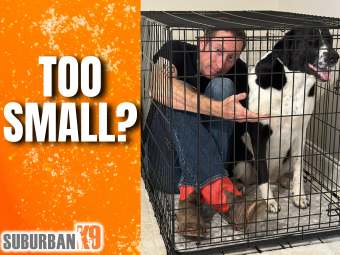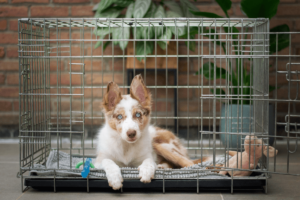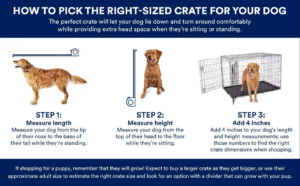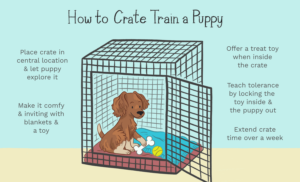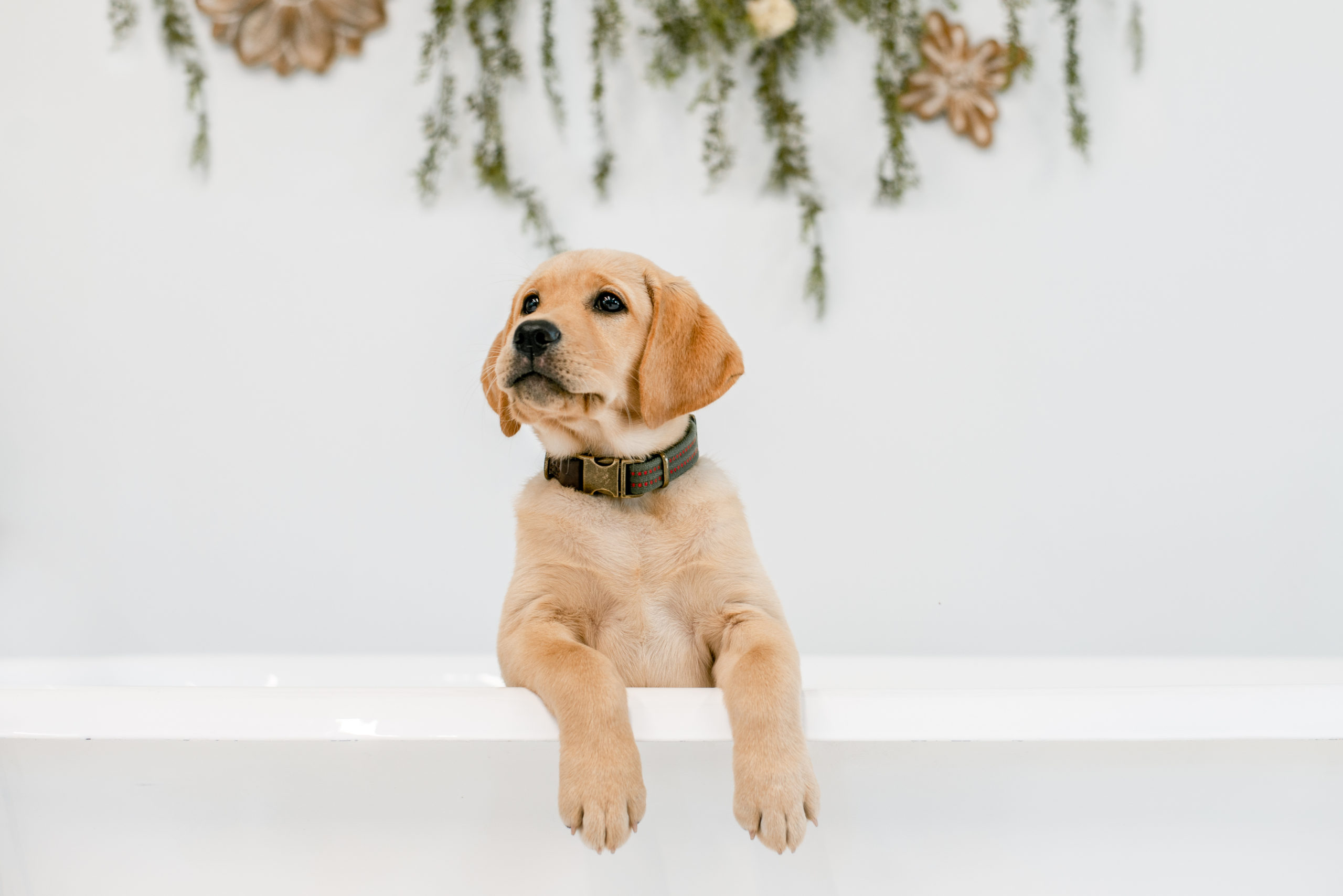Housebreaking a puppy can be a challenging task, but having the right dog crate size plays a crucial role in the process. A properly sized crate provides a safe and comfortable space for your puppy while aiding in their potty training. In this article, we will guide you through the process of selecting the perfect dog crate size for your growing pup. With the right crate size, you can create a positive environment that encourages your puppy's development and helps establish good behavior patterns.
Why Should I Crate Train My Dog?
Crate training is an essential aspect of raising a well-behaved and disciplined dog. While some people may have concerns about confining their furry friend, when done correctly, crate training provides numerous benefits for both the dog and the owner. Let's delve deeper into the importance of crate training:
Safety and Security:
Crates provide a safe and secure space for your dog, mimicking the den-like environments they would naturally seek in the wild. Dogs are den animals by nature, and having a crate provides them with a designated space that they can consider their own. This sense of security helps reduce anxiety and provides a retreat when your dog needs some alone time.
Preventing Accidents: Crate training plays a significant role in housebreaking and preventing accidents in the house. Dogs have a natural instinct to keep their sleeping area clean, and a properly sized crate can help reinforce this behavior. Dogs are less likely to eliminate in their crate, as it is considered their personal space. By using the crate as a tool for potty training, you can teach your dog to hold their bladder and bowels until they are taken outside.
If you are looking for help with potty training, try our Potty Training Academy:
Establishing a Routine:
Crate training helps establish a structured routine for your dog. Dogs thrive on consistency and predictability, and having a crate provides a reliable schedule for meals, bathroom breaks, and rest. By following a routine, your dog will learn when it's time to eat, sleep, and go outside for bathroom breaks, making them more predictable and easier to manage.
Reducing Destructive Behavior:
Crates can be an effective tool in preventing destructive behavior. When left unsupervised, puppies and even adult dogs may chew on furniture, shoes, or other household items. A crate provides a controlled environment where your dog can safely stay when you're not able to supervise them. This prevents them from engaging in destructive behaviors and keeps them out of harm's way.
Traveling and Vet Visits:
Crate training is particularly useful when it comes to traveling with your dog or taking them to the veterinarian. Many dogs find comfort in their crates, and having a familiar and secure space during these stressful situations can help reduce anxiety and make the experience more manageable for both you and your dog. Additionally, crates provide a safe way to transport your dog in a vehicle, ensuring their safety and preventing distractions while driving.
Independence and Confidence:
Properly crate training your dog can help foster independence and build their confidence. When your dog is comfortable and content in their crate, they can learn to be alone without experiencing separation anxiety. This skill is especially important for dogs that may need to spend time alone at home or in unfamiliar environments.
What Factors Should I Consider When Choosing a Crate Size?
Several factors should be taken into account when determining the appropriate crate size for your puppy. These factors include:
- Breed and Size: Different breeds have varying sizes, so it's important to research the average adult size of your puppy's breed. This will help you estimate the crate size your dog will need as they grow.
- Growth Potential: Puppies grow rapidly, so it's crucial to consider their growth potential when selecting a crate size. Opting for a crate with an adjustable divider panel can accommodate their increasing size. Dividers work wonders and can save money in the long run so that you don't have to continuously upgrade to a bigger crate size!
- Comfort and Safety: A crate should provide enough space for your puppy to stand, turn around, and lie down comfortably. However, a crate that is too large can hinder housebreaking efforts, as your puppy may use one area for sleeping and the other for going potty. Every time your puppy has an accident is a small step backward.
Looking for a heavy-duty travel crate? Check out our review of the Dakota 283 G3 Series of Kennels.
How do I Measure my Dog for the Right Crate Size?
To ensure the crate is a perfect fit for your puppy, you'll need to take accurate measurements. Here's a step-by-step guide to measuring your puppy for the right crate size:
- Height Measurement: With your puppy standing, measure from the floor to the top of their head. Add a few inches to this measurement to determine the minimum height of the crate.
- Length Measurement: Measure your puppy from the tip of their nose to the base of their tail. Again, add a few inches to this measurement to determine the minimum length of the crate.

- FARMHOUSE FURNITURE STYLE Featuring barn doors, farmhouse and bracket decor, the dog crate furniture is both modern and casual feel.
- WATER RESISTANT Baseboards are designed to be water resistant and anti-soak.
- REMOVABLE DIVIDER The removable divider design makes the dog cage more creative.
- sturdy and comfy dog crate creates a cozy space for the dog and brings it a sense of security.

- Sturdy Plastic Dog Crate: Securely and safely protect your pet and your home with this dog crate
- Suitable for Dogs of All Sizes: 5 different sizes to choose from
- Airline Friendly Dog Carrier: This pet carrier meets most airline cargo specifications
- Easy to Keep Clean: Sturdy plastic shell on this dog carrier is easy to clean

- LARGER ROOM Suitable for dog breeds up to 90lbs.
- TWO SPACIOUS ROOMS Features a removable divider.
- STURDY DOG CRATE Thick metal fence is solid while providing visibility and ventilation.
- EXTRA LARGE STORAGE This furniture dog crate has a large tabletop, and four drawers
- Pre-assembled parts make installation easy and convenient
Tips for Crate Training and Housebreaking
Once you have selected the appropriate crate size, it's time to introduce your puppy to their new den and begin the housebreaking process. Here are some tips to help you along the way:
- Positive Association: Create a positive association with the crate by making it a comfortable and inviting space. Add bedding, toys, and treats to make it more appealing to your puppy.
- Gradual Introductions: Introduce the crate gradually to avoid overwhelming your puppy. Start by leaving the crate door open and allow them to explore it at their own pace.
- Consistent Schedule: Establish a consistent schedule for crate usage, including regular feeding times and bathroom breaks. This routine will help your puppy understand when it's time to eliminate and when to rest.
- Potty Breaks: Take your puppy outside for regular potty breaks. As puppies have limited bladder control, it's essential to provide them with frequent opportunities to relieve themselves outside of the crate.
- Patience and Positive Reinforcement: Housebreaking takes time and patience. Use positive reinforcement techniques, such as verbal praise, every time the dog successfully goes potty outside like it's supposed to in order to reward your puppy for good behavior and reinforce their understanding of appropriate elimination habits.
Check out our article here for more in-depth advice about housebreaking!
Conclusion
Selecting the right dog crate size for your housebreaking puppy is a crucial step toward successful crate training. By considering your puppy's breed, growth potential, and measuring their dimensions accurately, you can ensure a comfortable and secure space for your furry friend. Remember to create positive associations with the crate and establish a consistent routine to reinforce good behavior. With patience, positive reinforcement, and the right crate size, you'll be well on your way to a well-behaved and housebroken pup. Happy training!
You May Also Be Interested In
 |
Should I Crate Train My Puppy
This crate training article goes over in detail everything you need to know about crating your dog. From training advice to selecting the right crate, this article can help. |
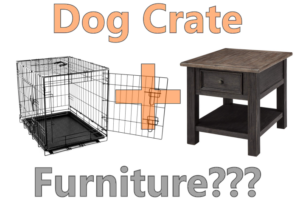 |
Dog Kennel Furniture Review
If you are looking for something a little bit of a less traditional dog crate check out our review of the different Dog Kennel Furniture pieces. |
The article above contains Affiliate Links from Amazon and other companies. If you visit their site and buy the product, we will get a small commission. Please know that we only recommend products we love and would never recommend a product we think is less than great. We look at and try hundreds of products before we ever recommend them to our clients!
